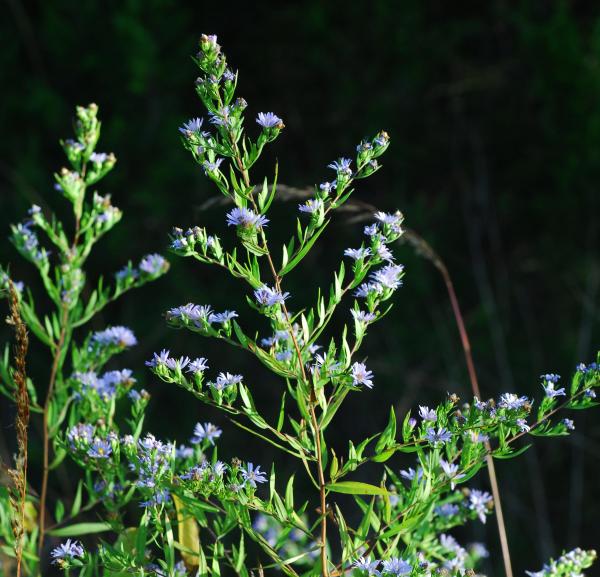Symphyotrichum praealtum (Poir.) G.L. Nesom
Willow-Leaved Aster

Native
CC = 6
CW = -3
MOC = 73
© SRTurner
Symphyotrichum praealtum (Poir.) G.L. NesomWillow-Leaved Aster | |
 |
Native CC = 6 CW = -3 MOC = 73 |
© SRTurner |
|
Family - Asteraceae/Astereae Habit - Perennial forb, often colonial from relatively long, slender, branched rhizomes. Stem - Ascending to erect, to 150 cm, usually single from the base, branched above the midpoint, sparsely to moderately pubescent toward the tip with hairs usually in longitudinal lines or bands, usually glabrous toward the base, often somewhat glaucous.
Leaves - Basal and lower stem leaves usually absent at flowering. Stem leaves simple, oblong, lanceolate, or elliptic, tapered at base, entire or sparsely toothed, sessile but not clasping. Venation on abaxial surface conspicuous.
Inflorescence - Panicles with spreading or ascending branches.
Heads - Radiate, 1.5-2.5 cm in diameter. Involucre 4-7 mm long, cup-shaped, the bracts in 4 or 5 unequal, overlapping series. Involucral bracts linear-lanceolate, angled or tapered at the bluntly or sharply pointed tip, lacking a spinelike point at the ascending tip, the slender midvein broadened gradually or more commonly relatively abruptly in the apical 1/4-1/2 into an elliptic or diamond-shaped green tip (2-5 times as long as wide), the outer surface glabrous, the margins often slightly irregular and sparsely to moderately hairy especially toward the tip.
Florets - Ray florets 20-35 in 1 or 2 series, pistillate, with lavender to purple ligules 5-12 mm long. Disk florets 20-35, perfect, yellow becoming red-brown after pollination, expanded portion of corolla exceeding narrow portion. Pappus bristles 4.0-6.5 mm long, white or off-white.
Fruits - Achenes 1.5-2.0 mm long, with 4 or 5 longitudinal ribs, purplish brown or tan with purple lines or streaks, sparsely to moderately hairy, the hairs lacking swollen bases. Flowering - August - October. Habitat - Wet prairies, streambanks, pond margins, fens, mesic and bottomland forests. Origin - Native to the U.S. Lookalikes - Several other species of Symphyotrichum. Other info. - This common species is found in wet areas across most of Missouri. The major part of its range is a band extending from Texas and Louisiana northward through Wisconsin and adjacent states, and into Canada. The moist habitat and the shape of the leaves and the prominent venation on their lower surfaces are good clues for identification. Photographs taken at Robertsville State Park, Franklin County, MO, 10-25-2010, and at Weldon Spring Conservation Area, St. Charles County, MO, 10-12-2015 (SRTurner). |